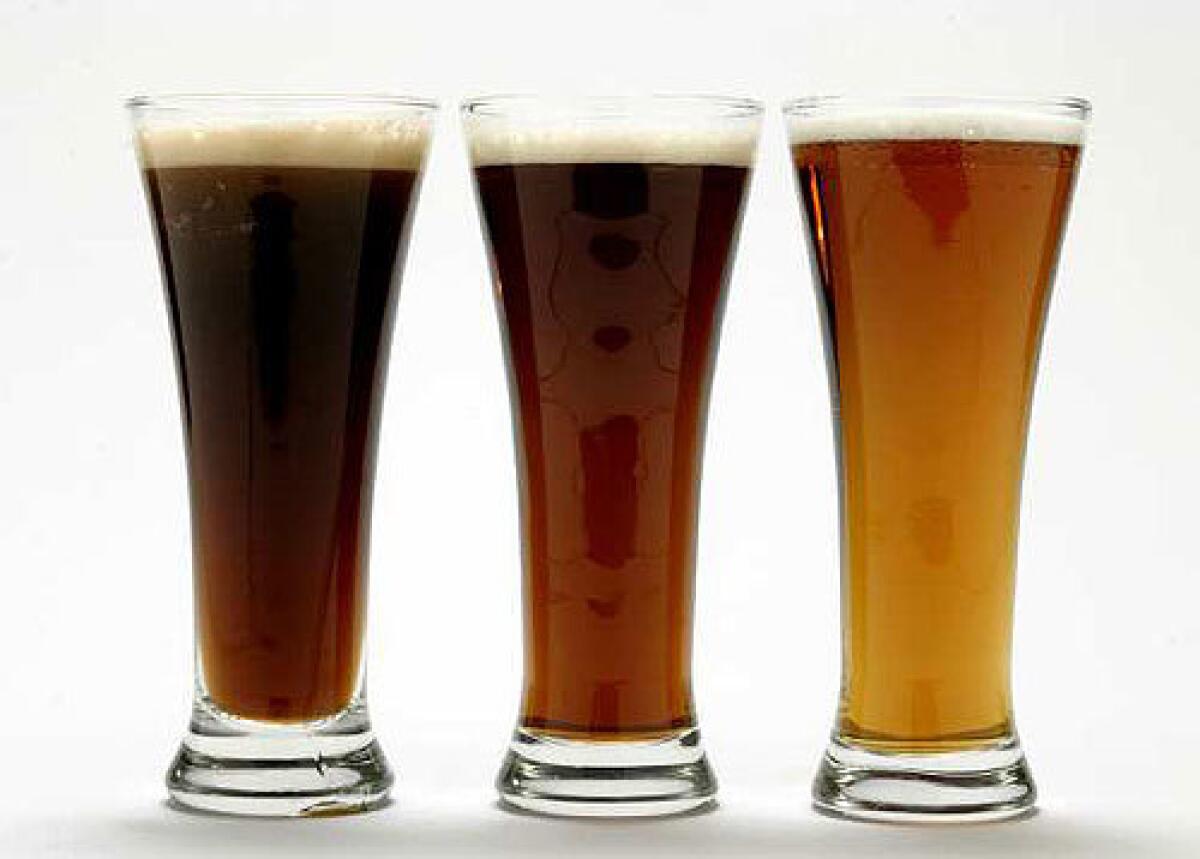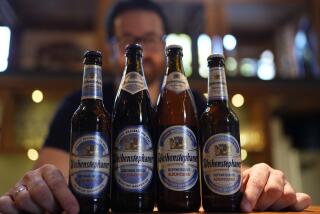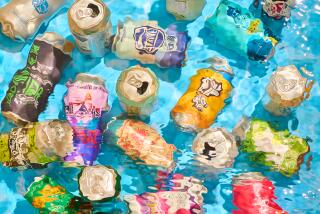Bock beer’s turn at the tap

- Share via
IN beer, the closest thing to the arrival of Beaujolais Nouveau is the annual tapping of the maibock keg at the Hofbräuhaus am Platzl in Munich — which happens next Wednesday.
This salute to spring doesn’t stir many ripples over here because Americans don’t know from bock. That’s a shame. They might find it a welcome change of pace from both ordinary lager and the sharply hopped ales that are the rage at craft breweries.
In brief, bock is a strong lager, heavy on the malt and light on the hops; a big, plush mouthful with few sharp edges. It combines the clean taste of a lager with some of the roasted flavors of a stout. If it were a wine, bock would be a soft Merlot, and a “highly extracted” one — maltier beer uses a higher proportion of grain per bottle.
Maltiness corresponds to protein content, so bocks tend to produce a thick head and leave a “lace” of bubbles on the sides of the glass, not to mention a protein savor in the mouth. Generally speaking, they’re a little sweeter than lagers and darker, ranging in color from pale amber to reddish brown.
Most brands on the market are imported. In its German homeland, bock is widely considered the official beer of spring and early summer and countless breweries make one. In fact, they tend to make bock all year round.
In this country, only two national breweries, Michelob and Samuel Adams, produce a bock, and most craft breweries don’t bother because so many customers are crazy for bitter, aggressively hopped pale ale. But not everybody is a “hophead.”
“The kind of person who doesn’t like a pale ale enjoys [bock],” says Bob Kluver, brewer at Main Street Brewing in Corona. “It’s not a light beer, it’s got a lot of body and flavor.”
Dan Gordon, director of brewing operations for the Palo Alto-born Gordon Biersch chain of brewery-restaurants, makes more bocks than anybody else in this country: an extra-strong Winterbock, Maibock (available in April and May, but only on draft at the restaurants) and the year-round Blonde Bock. “I’m a fanatic about bock,” says Gordon, who fell in love with the style while he was an exchange student in Germany. “It’s my pride-and-joy beer.”
A note of caution. Bock may come on mellow and easygoing, but it’s stronger than lager, as high as 8% or even 12% alcohol as opposed to lager’s 5%. Sean Dewitt, whose Coronado Brewing Co. brewpub in San Diego makes a bock called Bay Bridge, says wryly, “We get tired of forgetting to warn people, and they get loopy. This is a family restaurant, and the average Joe not even knowing what a bock is.”
There are many legends about how this amber brew originated, but the following is the generally accepted one. In the 16th century the north German town of Einbeck was known for strong beers, which it exported widely. To supply his court with good beer, Duke Maximilian I of Bavaria invited a leading Einbeck brewer to Munich around 1612, and the brewer adapted his style to the local malts. Munich’s water is alkaline, so Munich brewers were in the habit of roasting their malt, a process that produces acidity as well as a roasted flavor.
Voilà, a new style was born. And got a name; over the years, “Einbeck” was corrupted to “bock.”
In addition to the keg tapping at the Hofbräuhaus, there are at least three other dates each year when German beer lovers are said to switch to bock: Fasching (the pre-Lent season), “Strong Beer Season” (begins St. Joseph’s Day, March 19) and the tapping of the first keg of Paulaner Salvator (second Wednesday after Easter).
Drink up anytime
ALTHOUGH bock is a spring beer in most places, it turns out that it’s released in October and drunk throughout the winter in northern Bavaria, the Netherlands and Einbeck itself (where a brewery makes an excellent bock in Munich style).So do Germans just drink bock all the time?
The receptionist at the German Consulate General in Los Angeles gives an amused silvery laugh and passes the call on to Lars Leymann, the consulate’s press representative, who says, in effect, yes: “Traditionally, you just drink bock in spring and early summer, mostly April and May. But these days, you can drink it all year round.”
So the rule is clear: Drink bock whenever you feel like it.
But maibock (lighter in color, less malty and alcoholic) is always a seasonal style, brewed specifically for drinking in spring and summer. Only a few American craft breweries make a maibock, one being Sierra Nevada, whose Pale Bock is only available on draft.
“It has its fans,” says Steve Harrison, Sierra Nevada vice president, about his maibock. “Our problem is that we run out of tanks. There’s an eight- to nine-week lagering period for it.”
Doppelbock is an extra-malty and usually sweeter style, reportedly invented by Bavarian monks to sustain them during the Lenten fast. The first brand to be marketed was the Paulaner brewery’s Salvator. Because of its alcohol content, doppelbock would be what Americans call malt liquor, except that malt liquor is a cheaply made, nearly flavorless drink, whereas doppelbock is brimming over with flavor. Doppelbock is the leading style of bock in Germany today. Weizenbock is a wheat beer made in the strong, malty bock style. It’s fairly popular in Germany, but so far no American brewers seem to be attempting this style. Nor is anybody making (or soon likely to make) a commercial bock in the rauchbier (“smoke beer”) style of the city of Bamberg, which uses malt smoked over beechwood to make a smoky-tasting beer.Finally, a handful of German breweries make eisbock (ice bock), a dark beer approaching the quality of a carbonated liqueur, made by allowing the beer to freeze and then removing the ice, which concentrates the flavor (and the alcohol).
In this country, bock was close to dying out a few years ago. The only old-time bock breweries left are Spoetzl, in Shiner, Texas, and a handful of small local brands, mostly in the Midwest, such as Leinenkugel (whose ads use the image of a bottle of beer with a pencil standing up in it, to suggest how “thick” it is).
But it wasn’t just the love of hops that drove people to microbrews, it was a thirst for more flavor than they found in the average inoffensive American lager. When Michelob and Samuel Adams introduced bocks in the last decade, they seemed to see an opportunity in maltier beer. The highly developed range of bocks coming from Germany suggests this can be a very fruitful path.
In the meantime, if you want to try this bock stuff, this is the season. They’re going to be tapping that keg in Munich just a week from today.
More to Read
Eat your way across L.A.
Get our weekly Tasting Notes newsletter for reviews, news and more.
You may occasionally receive promotional content from the Los Angeles Times.










